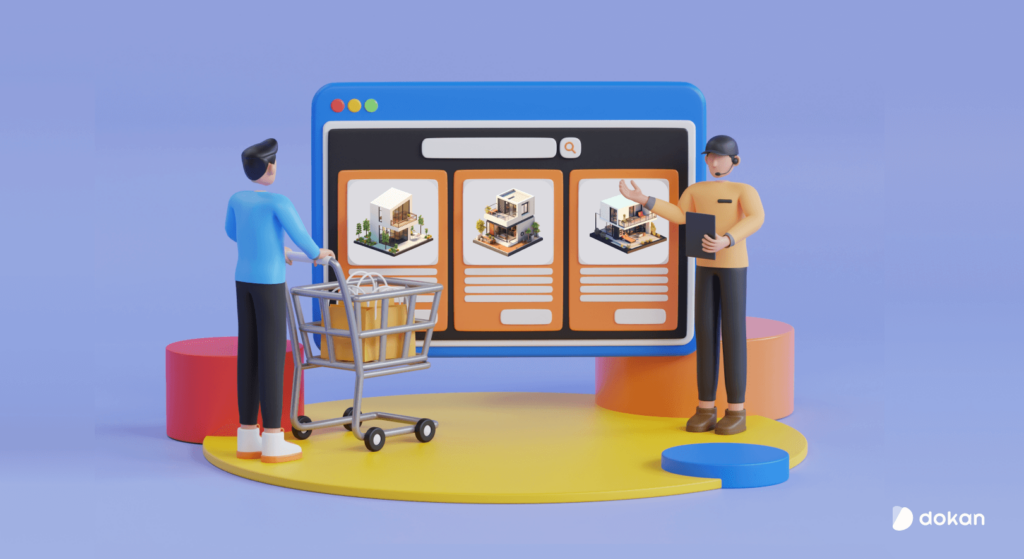11 Marketplace Mistakes and How to Avoid Them
[ad_1]
Building a marketplace is exciting. You bring buyers and sellers together, create a dynamic ecosystem, and (hopefully) watch your platform grow. It sounds like the perfect business model, right?
But here’s the reality: while marketplaces can be incredibly successful, they can also fail spectacularly if you make certain mistakes.
That’s why understanding the most common missteps is so important. Avoiding these marketplace mistakes will help you grow faster, save money, and keep your users and yourself happy.
In this post, we’ll break down the top 11 mistakes marketplace owners make and show you how to avoid them. Let’s dive in!
#Mistake1: Failing to Identify a Clear Target Audience
It’s easy to think your marketplace can serve everyone. After all, more buyers and sellers means more opportunities, right? But this approach often leads to failure.
Take Sarah, for example. She founded a marketplace in Atlanta that connects local artisans with customers looking to buy unique, handmade furniture.
Initially, she targeted “anyone who sells furniture” as sellers & “anyone who likes furniture” as buyers. But this broad focus created problems.


First, Sarah didn’t define her ideal customers clearly.
→ On the seller side, she had no strategy for attracting top-quality artisans. Some sellers were inexperienced, which hurt the overall reputation of the marketplace.
→ On the buyer side, she tried to appeal to “everyone who buys furniture”. But this included budget-conscious shoppers who weren’t willing to pay a premium for custom pieces.
Sarah’s marketing was scattered, and her messaging didn’t speak to buyers or sellers meaningfully. The result?
While she got traffic, her marketplace attracted the wrong kind of sellers who couldn’t offer the quality buyers expected. And her buyers, in turn, weren’t interested in paying higher prices for handmade goods.
The Possible Solution: Sarah should have defined clear buyer and seller personas instead of trying to please everyone.
For example, targeting high-end interior designers as buyers and experienced craftsmen as sellers would have made her marketing efforts more effective and her platform more attractive to both sides.
When building your marketplace, spend time researching both your buyers and sellers. Understand their pain points, preferences, and expectations. This focused approach will help you create better experiences for both groups and avoid wasting resources on broad, ineffective marketing.
#Mistake 2: Choosing the Wrong Revenue Model
Many marketplace owners make the mistake of selecting a revenue model that doesn’t align with their users’ needs or behavior. This can lead to unhappy users, lower engagement, and ultimately, a marketplace that struggles to survive.
Let me tell you the story of Jason. He launched a marketplace in Denver that connects freelance graphic designers with small business owners. Jason initially decided to charge a flat subscription fee for both designers and businesses, thinking it would be the easiest way to generate steady income.
However, the model quickly backfired.
On the designer side, many were hesitant to pay a subscription fee upfront without knowing if they’d get enough gigs to justify the cost.
On the buyer side, small business owners weren’t ready to commit to a monthly fee without knowing if they’d find the right talent.
Jason’s platform attracted users, but they weren’t willing to pay a recurring fee. As a result, the marketplace had low conversion rates and struggled to generate consistent revenue.
The Possible Solution: Jason should have considered a commission-based model. So, the marketplace earns a small percentage of each project completed rather than charging users an upfront fee. This would have aligned better with both sides of his marketplace.
Jason should follow this structure for his marketplace-
- Freelancers will only pay when they successfully secure work, which makes the cost feel more fair and less risky.
- Small business owners can try the platform without a subscription fee. They only need to pay when they hire a designer.
When choosing a revenue model, think carefully about how your users behave. Do they prefer paying upfront, or would they rather pay as they go? Make sure your model aligns with their needs and expectations to keep both buyers and sellers happy.
#Mistake 3: Failing to Choose the Right Marketplace Solution


Selecting the right platform for your marketplace can make or break your business. If you pick the wrong solution, you could face costly delays, tech headaches, and frustrated users.
For example, custom platforms often seem like a good idea in the beginning, but they require constant updates and are prone to bugs. On the other hand, using a generic eCommerce solution may seem easier. However, it can fall short when it comes to supporting multiple vendors.
The Possible Solution: To avoid these issues, choose a platform built specifically for running a marketplace. Dokan is a great option for creating multi-vendor marketplaces quickly and easily. With Dokan, you get all the features you need right out of the box:
- Vendor management, including customizable store pages
- Order and product management for both sellers and buyers
- Built-in payment gateways and commission handling
Dokan is flexible, scalable, and designed to grow with your business. So you won’t have to worry about constant tech fixes or missing features.
When selecting a platform, consider what features are non-negotiable for your marketplace. Does the solution provide all the tools you need to manage vendors, payments, and users effectively? Picking the right platform from the start will save you a lot of time and effort in the long run.
#Mistake 4: Ignoring Platform Scalability
When you first launch a marketplace, it can be tempting to focus only on getting things off the ground. But if you don’t plan for growth from the start, you might find yourself stuck later on when your platform needs to handle more traffic, vendors, or products.
Imagine a marketplace that launches with a small group of vendors and a handful of buyers. At first, everything runs smoothly. But as the platform gains traction and the number of users grows, the system starts to slow down.
The Solution: To avoid these problems, make scalability a priority when choosing your marketplace platform. Choose a solution that’s built to grow with your business, like Dokan, which offers flexible features and performance capabilities for growing marketplaces.
Additionally, plan ahead by:
- Choosing a cloud-based hosting solution that can easily scale as your user base grows.
- Implementing a content delivery network (CDN) to speed up page load times across different regions.
- Ensuring your platform supports multi-vendor features like automatic vendor registration, order management, and commission handling—without extra manual effort.
Building with scalability in mind means you won’t have to worry about the growing pains as your marketplace expands. It’s better to invest in a scalable platform from the start than to face costly upgrades and user dissatisfaction down the line.


Subscribe to
Dokan blog
#Mistake 5: Overlooking Trust and Safety
In any online marketplace, trust is everything. Buyers and sellers need to feel confident that they are dealing with reliable people and secure transactions. Failing to prioritize trust and safety can quickly damage your reputation and drive users away.
You’re running a marketplace for second-hand electronics. If your customers can’t trust that the products are genuine or that they’ll receive what they paid for, they won’t feel comfortable making a purchase.
Similarly, sellers may not feel comfortable listing their items if they’re worried about getting scammed. Without proper safeguards, both sides are at risk, and your platform may lose credibility fast.
The Possible Solution: To build trust, focus on the following key areas:
- Clear Verification Processes: Ensure that both buyers and sellers have their identities verified, either through email, phone, or social media accounts. This reduces the chances of fraud and builds accountability within your marketplace.
- Secure Payment Systems: Use trusted payment gateways that protect sensitive information and offer buyer/seller protection. This ensures smooth and safe transactions.
- Transparent Policies: Clearly outline your platform’s rules, including return policies, dispute resolution processes, and guarantees. When users know what to expect, they’re more likely to feel comfortable using your marketplace.
- User Reviews and Ratings: Allow buyers to leave reviews and rate sellers. Positive feedback builds credibility for sellers and gives buyers confidence in their purchasing decisions.
By focusing on trust and safety from the start, you can create a marketplace where both buyers and sellers feel secure, leading to a stronger, more loyal user base. The more trustworthy your platform is, the more likely users will recommend it and return for future transactions.
#Mistake 6: Poor Onboarding Experience


The first impression matters. When users—whether buyers or sellers—sign up for your marketplace, they need a smooth, intuitive onboarding process. If it’s confusing or takes too long, you may lose them before they even get started.
Take Lena, who recently launched a marketplace in Portland, Oregon, for handmade, locally-sourced beauty products. She had big dreams for her platform, but her onboarding process was overly complicated.
When new sellers signed up, they were bombarded with lengthy forms, unclear instructions, and a confusing dashboard. They struggled to upload their products and set up their stores. On the buyer side, the registration process required too many steps, and users often abandoned the process before completing it.
As a result, Lena’s marketplace had low user engagement.
Sellers didn’t stick around because they couldn’t easily set up their shops and buyers couldn’t figure out how to complete a purchase. Despite having great products, the poor onboarding experience was a major roadblock to growth.
The Solution: To create a seamless onboarding experience, focus on simplicity and clarity:
- Step-by-step guidance: Break the process into easy, manageable steps. For sellers, provide clear instructions on how to create a store, upload products, and set prices. For buyers, make the registration process quick and easy.
- User-friendly design: Ensure the interface is intuitive. Use tooltips, progress bars, and other helpful features to guide users through the process without overwhelming them.
- Offer support: Provide easy access to help through FAQs, live chat, or tutorials. This ensures users have the resources they need if they get stuck.
By improving the onboarding experience, you can ensure that both buyers and sellers have a positive first interaction with your platform.
#Mistake 7: Ineffective Marketing Strategies
It’s not enough to just have a great marketplace. You need to tell people about it in the right way. Many marketplace owners fail to create an effective marketing strategy that targets the right channels, measures performance, and optimizes over time.
The result? → Wasted budgets, low engagement, and slow growth.
Let’s look at “FitnessGearHub”, a marketplace that connects fitness equipment sellers with buyers. The owner, Tom, tried running ads on Facebook and Instagram but without any clear strategy or monitoring. He boosted posts randomly, used broad targeting, and never tested which ads worked best.
Here’s what happened:
| Marketing Tactic | Ad Spend | Impressions | Clicks | Conversions (Sales) | Cost per Conversion |
|---|---|---|---|---|---|
| Random Facebook & Instagram Ads | $6,000 | 400,000 | 5,000 | 50 | $120 |
| Paid Search Ads (targeting specific fitness gear keywords) | $6,000 | 100,000 | 15,000 | 500 | $12 |
In the first campaign, Tom spent $6,000 on random social media ads that didn’t have clear targeting. As a result, he received very few clicks and had a high cost per conversion.
In the second campaign, Tom focused on paid search ads, targeting specific keywords like “buy gym equipment online” and “best home fitness gear”. This approach made his ad spend go further, resulting in far more conversions at a much lower cost per sale.
The Possible Solution: To improve your marketing, focus on these strategies:
- Measure and optimize: Track performance with analytics. What channels are driving traffic? What ads are converting? Use this data to optimize your campaigns continuously.
- Focus on high-intent channels: Invest in marketing channels where your customers are actively looking for what you offer. For example, paid search ads are great for people who already have a specific need or are searching for a solution.
- Test and iterate: Always A/B test your ads, copy, and targeting. This allows you to refine your messaging and ensure you’re using your budget efficiently.
- Use content marketing to build trust: Regular blog posts, tutorials, customer stories, and videos help establish your marketplace as an authority in your niche. High-quality content attracts organic traffic and builds long-term brand awareness.
You need to be strategic with your marketing efforts and continuously test what works. In this way, you can spend your budget more wisely, increase conversions, and build a loyal user base.
#Mistake 8: Lack of Seller and Buyer Engagement


A successful marketplace relies on active participation from both sellers and buyers. If either group isn’t engaged, the platform can quickly lose momentum. Sellers may stop listing products, while buyers may stop making purchases.
Many marketplace owners focus too much on attracting users but fail to keep them engaged over time. Without strategies to encourage interaction and loyalty, users may lose interest and go elsewhere.
The Possible Solution: To keep both buyers and sellers engaged, consider these actionable tips:
- Create Seller Incentives: Offer features like promotional tools, discounts for high-volume sellers, or priority listing spots.
- Engage Buyers with Personalized Content: Use personalized recommendations or email campaigns based on buyer behavior.
- Build a Community: Create spaces for buyers and sellers to interact—whether through forums, reviews, or social media groups.
- Offer Loyalty Programs: Reward repeat buyers with points, discounts, or exclusive deals.
Engagement strategies are essential for keeping users active and invested in your marketplace. When both sellers and buyers feel valued and connected, they’re more likely to remain loyal.
#Mistake 9: Underestimating Competition
In the world of online marketplaces, competition is fierce. Many marketplace owners focus so much on building their own platform that they forget to assess what their competitors are doing—both well and poorly.
Megan launched VintageVibes, a marketplace for vintage clothing in Los Angeles. She thought her idea was unique and the market for secondhand fashion was growing rapidly. She built the platform with great features, high-quality images, and seamless payments. However, Megan didn’t spend enough time analyzing her competitors.
A few months after launch, traffic stagnated, and sellers struggled to make sales. Upon review, Megan realized that platforms like ThredUp and Poshmark already had large user bases, strong brand loyalty, and added features like personalized styling and free shipping.
The Possible Solution: It’s essential to know who you’re up against. Track their pricing, customer service, and marketing tactics to understand what they’re doing well and where they’re lacking.
What You Can Do vs. What Megan Missed:
| What Megan Missed | What You Can Do |
|---|---|
| Ignoring Competitor Strengths: Megan didn’t analyze what her competitors were doing well. | Research Your Competitors: Dive into what your competitors offer. Examine their strengths and weaknesses. What are they doing right? Where are they lacking? Learn from them. |
| No Unique Selling Proposition (USP): Megan didn’t carve out a unique niche for her marketplace. | Develop Your USP: Find what makes your marketplace different. Are you offering unique products? A better user experience? A niche market others aren’t tapping into? Identify what sets you apart. |
| Failing to Track Industry Trends: Megan missed key trends, like the eco-conscious movement in fashion. | Stay Ahead of Trends: Keep a close watch on trends in your industry. If there’s a growing demand for sustainable fashion, adjust your marketplace to address that shift before your competitors do. |
#Mistake 10: Neglecting Mobile Optimization
Today, mobile commerce is not just a trend—it’s the reality. With over half of all online shopping happening on mobile devices, ignoring mobile optimization for your marketplace is a huge mistake.
When users browse your marketplace from their phones, they expect smooth and fast experiences. If your platform takes too long to load, or if buttons are hard to tap, or if the checkout process is a nightmare, they’ll quickly abandon their shopping cart.
Poor mobile optimization is a one-way ticket to lost sales.
The Possible Solution: Here are five things you can start focusing on today:
- Think mobile-first design: Prioritize designing for mobile. Make sure the mobile experience is as smooth as or better than the desktop version.
- Optimize for speed: Mobile users expect fast-loading pages. Compress images, reduce redirects, and minimize JavaScript to boost speed.
- Simplify navigation: Mobile screens are small, so make sure buttons are easy to tap and navigation is intuitive. Keep it simple and clear.
- Streamline the checkout process: A long, complicated checkout can lead to abandoned carts. Offer quick payment options, minimize steps, and make forms easy to fill.
- Test across devices: Regularly test your marketplace on multiple devices like smartphones, tablets, and different browsers to make sure everything works seamlessly.
The goal here is simple ➡️ Make shopping on your marketplace as easy and enjoyable as possible on mobile. A smooth mobile experience leads to happier customers, more purchases, and ultimately, a stronger business.
#Mistake 11: Prioritizing Growth Over User Experience
Let’s take a quick look at FitGear, a fitness equipment marketplace that gained 10,000 new users in just 3 months. Sounds great, right? But their sales weren’t growing. Here’s why:
- 50% bounce rate: Half of visitors left the site within seconds because it was hard to navigate.
- 30% cart abandonment: Users started checkout but gave up due to a complicated process.
- 20% retention rate: Only 2,000 out of 10,000 users returned to buy again because of a poor mobile experience.
In short: Fast growth with a poor user experience means lost revenue.
The Possible Solution: To fix this, FitGear needs to make a few changes. First, users need to find what they want quickly. A clear, simple layout helps keep visitors on the site longer.
Next, a seamless, one-page checkout process reduces cart abandonment. The easier the checkout, the more likely users are to complete their purchase.
The site also needs to load faster and be optimized for mobile. If users have a smoother experience on their phones, they’ll return more often.
Improving page speed is crucial. Even a 1-second delay can reduce conversions by 7%, so optimizing images and cutting unnecessary steps makes a big difference.
Finally, regularly collecting user feedback helps identify pain points early and fix them before users give up.
Avoid Common Marketplace Mistakes to Speed Up Your Growth
Building a marketplace is no small feat, but avoiding these common mistakes will help you set your platform up for long-term success.
Focus on identifying your audience, choosing the right tech, and ensuring your platform is both scalable and user-friendly.
So, are you ready to take on the challenge?
Share your marketplace experiences in the comments below. What mistakes have you encountered or what tips do you want to share from your own journey?
Subscribe to
Dokan blog
We send weekly newsletters, no spam for sure!


[ad_2]
منبع:dokan


